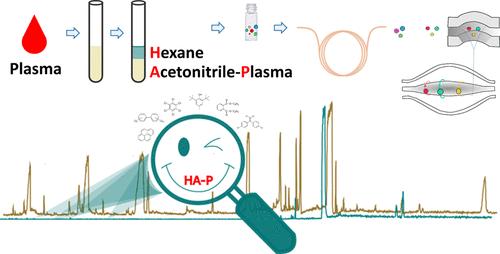当前位置:
X-MOL 学术
›
Environ. Sci. Technol.
›
论文详情
Our official English website, www.x-mol.net, welcomes your
feedback! (Note: you will need to create a separate account there.)
Chemical Exposomics in Human Plasma by Lipid Removal and Large-Volume Injection Gas Chromatography–High-Resolution Mass Spectrometry
Environmental Science & Technology ( IF 10.8 ) Pub Date : 2024-09-24 , DOI: 10.1021/acs.est.4c05942 Hongyu Xie, Kalliroi Sdougkou, Bénilde Bonnefille, Stefano Papazian, Ingvar A. Bergdahl, Panu Rantakokko, Jonathan W. Martin
Environmental Science & Technology ( IF 10.8 ) Pub Date : 2024-09-24 , DOI: 10.1021/acs.est.4c05942 Hongyu Xie, Kalliroi Sdougkou, Bénilde Bonnefille, Stefano Papazian, Ingvar A. Bergdahl, Panu Rantakokko, Jonathan W. Martin

|
For comprehensive chemical exposomics in blood, analytical workflows are evolving through advances in sample preparation and instrumental methods. We hypothesized that gas chromatography–high-resolution mass spectrometry (GC-HRMS) workflows could be enhanced by minimizing lipid coextractives, thereby enabling larger injection volumes and lower matrix interference for improved target sensitivity and nontarget molecular discovery. A simple protocol was developed for small plasma volumes (100–200 μL) by using isohexane (H) to extract supernatants of acetonitrile-plasma (A-P). The HA-P method was quantitative for a wide range of hydrophobic multiclass target analytes (i.e., log Kow > 3.0), and the extracts were free of major lipids, thereby enabling robust large-volume injections (LVIs; 25 μL) in long sequences (60–70 h, 70–80 injections) to a GC-Orbitrap HRMS. Without lipid removal, LVI was counterproductive because method sensitivity suffered from the abundant matrix signal, resulting in low ion injection times to the Orbitrap. The median method quantification limit was 0.09 ng/mL (range 0.005–4.83 ng/mL), and good accuracy was shown for a certified reference serum. Applying the method to plasma from a Swedish cohort (n = 32; 100 μL), 51 of 103 target analytes were detected. Simultaneous nontarget analysis resulted in 112 structural annotations (12.8% annotation rate), and Level 1 identification was achieved for 7 of 8 substances in follow-up confirmations. The HA-P method is potentially scalable for application in cohort studies and is also compatible with many liquid-chromatography-based exposomics workflows.
中文翻译:

通过脂质去除和大容量注射气相色谱-高分辨率质谱法对人血浆进行化学暴露组学分析
对于血液中的综合化学暴露组学,分析工作流程正在随着样品制备和仪器方法的进步而发展。我们假设气相色谱-高分辨率质谱 (GC-HRMS) 工作流程可以通过最大限度地减少脂质共提取物来增强,从而实现更大的进样体积和更低的基质干扰,从而提高靶标灵敏度和非靶标分子发现。通过使用异己烷 (H) 提取乙腈血浆 (A-P) 的上清液,为小体积血浆 (100–200 μL) 开发了一种简单的方案。HA-P 方法对多种疏水性多类目标分析物(即 log Kow > 3.0)进行定量分析,并且提取物不含主要脂质,因此能够对 GC-Orbitrap HRMS 进行稳定的大体积进样 (LVI;25 μL) 长序列(60-70 小时,70-80 次进样)。如果不去除脂质,LVI 会适得其反,因为方法灵敏度会受到丰富的基质信号的影响,导致 Orbitrap 的离子进样时间较短。方法定量限中位数为 0.09 ng/mL(范围 0.005–4.83 ng/mL),认证参比血清的准确度良好。将该方法应用于瑞典队列 (n = 32;100 μL) 的血浆,检测到 103 种目标分析物中的 51 种。同时进行非靶标分析得到 112 个结构注释 (注释率为 12.8%),在随访确认中,8 种物质中有 7 种实现了 1 级鉴定。HA-P 方法具有潜在的可扩展性,可用于队列研究,并且还与许多基于液相色谱的暴露组学工作流程兼容。
更新日期:2024-09-24
中文翻译:

通过脂质去除和大容量注射气相色谱-高分辨率质谱法对人血浆进行化学暴露组学分析
对于血液中的综合化学暴露组学,分析工作流程正在随着样品制备和仪器方法的进步而发展。我们假设气相色谱-高分辨率质谱 (GC-HRMS) 工作流程可以通过最大限度地减少脂质共提取物来增强,从而实现更大的进样体积和更低的基质干扰,从而提高靶标灵敏度和非靶标分子发现。通过使用异己烷 (H) 提取乙腈血浆 (A-P) 的上清液,为小体积血浆 (100–200 μL) 开发了一种简单的方案。HA-P 方法对多种疏水性多类目标分析物(即 log Kow > 3.0)进行定量分析,并且提取物不含主要脂质,因此能够对 GC-Orbitrap HRMS 进行稳定的大体积进样 (LVI;25 μL) 长序列(60-70 小时,70-80 次进样)。如果不去除脂质,LVI 会适得其反,因为方法灵敏度会受到丰富的基质信号的影响,导致 Orbitrap 的离子进样时间较短。方法定量限中位数为 0.09 ng/mL(范围 0.005–4.83 ng/mL),认证参比血清的准确度良好。将该方法应用于瑞典队列 (n = 32;100 μL) 的血浆,检测到 103 种目标分析物中的 51 种。同时进行非靶标分析得到 112 个结构注释 (注释率为 12.8%),在随访确认中,8 种物质中有 7 种实现了 1 级鉴定。HA-P 方法具有潜在的可扩展性,可用于队列研究,并且还与许多基于液相色谱的暴露组学工作流程兼容。













































 京公网安备 11010802027423号
京公网安备 11010802027423号